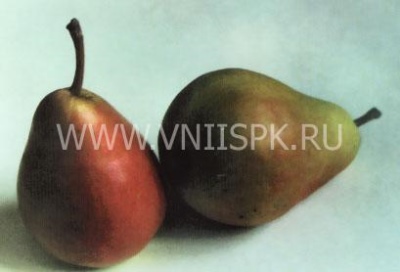
- Authors: P. V. Grozditsky, I. N. Boyko, E. A. Avramenko, G. I. Kulikov, I. N. Maksimova, Institute of Irrigated Horticulture UAAS
- Appeared when crossing: Bere Bosk x Tolstobezhka
- Year of approval: 1993
- Fruit weight, g: 200—250
- Ripening terms: summer
- Fruit picking time: August 20-30
- Appointment: fresh
- Growth type: medium height
- Yield: high
- Transportability: good
In the 1980s, breeders achieved quite impressive successes, and the results of their work at that time were not inferior to modern achievements. One of the confirmations of this thesis is the Victoria pear. But it must be studied and considered thoroughly in order to exclude errors.
Breeding history
The plant was created at the Kiev Institute of Irrigated Horticulture. The variety was registered and approved for use in 1993. The work on the project was carried out by a whole team of breeders - at least 5 large specialists. Victoria was obtained by crossing Bere Bosk and Tolstobezhka pears.
Description of the variety
Medium-sized trees will form a crop on ringlets. Moderately dense crown of a rounded pyramidal shape. It is quite compact and does not pose any significant problems. Fruit shedding is uncharacteristic. But the susceptibility of this variety to apomixis is noted.
Fruit characteristics
Victoria pears, classic in shape and uniform in size, weigh 0.2-0.25 kg. Their other main properties are as follows:
- yellow ruddy color;
- periodically detected rust spots;
- long and moderately thick peduncle;
- optimal shelf life, which is about 1 month (with enhanced cooling, pears are stored much longer);
- the proportion of dry matter is 13%;
- noticeable content of ascorbic acid.
Taste qualities
The share of sugars in apples reaches 7-8%. Acid concentration - no more than 0.4%. Therefore, the sweet taste definitely dominates the sourness, and together they form an attractive ensemble. The white pulp is tender and juicy.
Ripening and fruiting
In terms of reaching ripeness, this variety is referred to as summer pears. It is usually possible to harvest the fruits in the last decade of August. Only occasionally do weather conditions make adjustments to this usual schedule. The required consumer ripeness is reached by mid-September and lasts about 30 days. New apples will appear normally every year, without interruption.

Yield
On average, up to 200 kg of fruit can be harvested from 1 Victoria tree. Compared to many other pears, this is quite a decent indicator. Importantly, the harvested crop is easily transported, so the crop has good commercial prospects.
Growing regions
In Russia, this variety is recommended for North Ossetia. Growing anywhere outside the North Caucasus is almost impossible. However, unofficial sources claim that Victoria is successfully grown in Belarus. Therefore, you can still try to dilute it in the middle lane.
Self-fertility and the need for pollinators
The plant is partially self-fertile. For pollination, it is recommended to plant nearby Williams Red and Viennese Triumph trees.
Landing
Despite the unpretentiousness of such a pear, it is better to plant it where it will be provided with soil fertility and stable irrigation. Sunlit southern or southeastern areas are best suited. It is very good if there is a moderately dense sandy loam or the same loam. Victoria's roots can be affected by high groundwater levels. It is also worth paying attention to other circumstances:
- it is better to choose seedlings 1-2 years old;
- the depth of the planting pits should be 60 or 70 cm;
- their optimal width is 90 cm;
- it is recommended to place trees according to the 4x5 m system;
- before planting, the roots should be kept in a stimulating solution for 120 to 180 minutes.


Growing and caring
Mature trees in Victoria can handle drought well. But young seedlings will have to be watered more actively. In addition, at extremely high temperatures, it is important to irrigate even sturdy pears diligently. This should be done once every 7 days, using 10 liters of water for each plant. Trees must be watered before flowering and immediately after it ends, and then 2 or 3 more times during active fruiting.
Important: if precipitation is stable, it makes no sense to water the pears more than 2 or 3 times per season. At the same time, we must not forget about the autumn water-charging irrigation. The culture is responsive to feeding. They must be entered in the second year from the moment of disembarkation to a permanent place, then this is done annually. Organic matter is applied intermittently for 3-4 years, and at the beginning of spring, nitrogen-containing fertilizers are used. In late autumn, it is more correct to use phosphorus fertilizers.
The first pruning is done in the spring in the second year. We must finish it before the juices move. After 4-5 years, the third skeletal level is formed. Traditionally, whitewashing is also needed for pear trees. Before the onset of cold weather, the trunk is covered with spruce branches.



Disease and pest resistance
The ability to resist scab infestation is declared. Also, the official description insists on high immunity to damage by pathological fungi. The pests will be the same as in other pear trees, and the preventive measures do not differ.

Like any other fruit trees, the pear needs protection from various diseases and pests. When planting a pear on your site, you need to know in advance what diseases you should beware of. To successfully carry out the struggle, it is necessary first to correctly identify the cause of the problem.It is important to distinguish signs of disease from manifestations of the presence of insects, mites, caterpillars and other types of pests.





































































